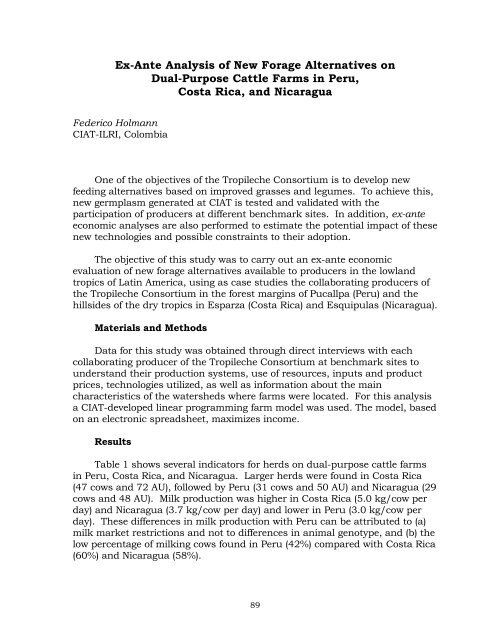Feeding Systems with Legumes to Intensify Dairy Farms - cgiar
Feeding Systems with Legumes to Intensify Dairy Farms - cgiar
Feeding Systems with Legumes to Intensify Dairy Farms - cgiar
You also want an ePaper? Increase the reach of your titles
YUMPU automatically turns print PDFs into web optimized ePapers that Google loves.
Ex-Ante Analysis of New Forage Alternatives on<br />
Dual-Purpose Cattle <strong>Farms</strong> in Peru,<br />
Costa Rica, and Nicaragua<br />
Federico Holmann<br />
CIAT-ILRI, Colombia<br />
One of the objectives of the Tropileche Consortium is <strong>to</strong> develop new<br />
feeding alternatives based on improved grasses and legumes. To achieve this,<br />
new germplasm generated at CIAT is tested and validated <strong>with</strong> the<br />
participation of producers at different benchmark sites. In addition, ex-ante<br />
economic analyses are also performed <strong>to</strong> estimate the potential impact of these<br />
new technologies and possible constraints <strong>to</strong> their adoption.<br />
The objective of this study was <strong>to</strong> carry out an ex-ante economic<br />
evaluation of new forage alternatives available <strong>to</strong> producers in the lowland<br />
tropics of Latin America, using as case studies the collaborating producers of<br />
the Tropileche Consortium in the forest margins of Pucallpa (Peru) and the<br />
hillsides of the dry tropics in Esparza (Costa Rica) and Esquipulas (Nicaragua).<br />
Materials and Methods<br />
Data for this study was obtained through direct interviews <strong>with</strong> each<br />
collaborating producer of the Tropileche Consortium at benchmark sites <strong>to</strong><br />
understand their production systems, use of resources, inputs and product<br />
prices, technologies utilized, as well as information about the main<br />
characteristics of the watersheds where farms were located. For this analysis<br />
a CIAT-developed linear programming farm model was used. The model, based<br />
on an electronic spreadsheet, maximizes income.<br />
Results<br />
Table 1 shows several indica<strong>to</strong>rs for herds on dual-purpose cattle farms<br />
in Peru, Costa Rica, and Nicaragua. Larger herds were found in Costa Rica<br />
(47 cows and 72 AU), followed by Peru (31 cows and 50 AU) and Nicaragua (29<br />
cows and 48 AU). Milk production was higher in Costa Rica (5.0 kg/cow per<br />
day) and Nicaragua (3.7 kg/cow per day) and lower in Peru (3.0 kg/cow per<br />
day). These differences in milk production <strong>with</strong> Peru can be attributed <strong>to</strong> (a)<br />
milk market restrictions and not <strong>to</strong> differences in animal genotype, and (b) the<br />
low percentage of milking cows found in Peru (42%) compared <strong>with</strong> Costa Rica<br />
(60%) and Nicaragua (58%).<br />
89
















